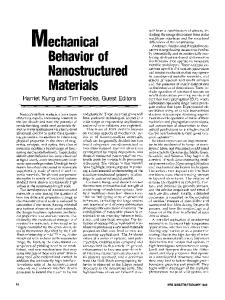Structure and mechanical behavior relationship in nano-scaled multilayered materials
- PDF / 1,164,973 Bytes
- 6 Pages / 612 x 792 pts (letter) Page_size
- 45 Downloads / 363 Views
Structure and mechanical behavior relationship in nano-scaled multilayered materials A.Sergueeva, N.Mara, A.K.Mukherjee Department of Chemical Engineering and Materials Science, University of California, Davis, CA 95616, U.S.A. ABSTRACT Multilayered foils with 10%Cu/90%Ni and different bi-layer thickness (100-1000 nm) have been fabricated by electrodeposition. TEM and x-ray diffraction analysis indicate discrete layer formation and a (100) textured structure. The maximum tensile strength (590 MPa) is obtained for foils with the smallest layer thickness. Preliminary results on high temperature deformation show a strong dependence of strength and plasticity on layer thickness. INTRODUCTION Multilayered films form a very important group of materials and there is significant interest in studing their fundamental physical properties [1]. More specifically, nanometer-scale polycrystalline multilayered films (with layer thickness less than 100 nm) have been the subject of many recent experimental and theoretical studies [2-5]. These fine-scale composite materials typically exhibit high yield strength, which at room temperature can approach one-half of the theoretical strength. Most attempts to characterize the mechanical behavior of such thin films have been carried out using nanoindentation and scanning force microscopy or their combination and there are no data regarding their mechanical behavior at elevated temperatures. In the present investigation, the microstructure and mechanical properties of polycrystalline Cu-Ni nanolayered composites prepared by electrodeposition were evaluated. Samples were tested in uniaxial tension at room and elevated temperature using a custom-built computer controlled constant strain rate tensile test machine. This allows testing of very small samples with a 1-mm gage length and thicknesses as small as 5 µm, providing new opportunities in mechanical characterization of multilayered materials. The high strength of these new materials is attributed to their layered, nanoscale structure and a variety of related strengthening mechanisms. Variations in composition, stiffness, residual elastic strain, crystal structure and interfacial defects are expected to impede dislocation glide between layers, while intralayer grain boundaries and nanoscale grains restrict dislocation motion within layers. Mechanical testing data suggests that some of these strengthening mechanisms are active in multilayers. EXPERIMENTAL DETAILS The 10%Cu-90%Ni multilayers with bi-layer thickness of 100, 300 and 1000 nm have been fabricated by electrodeposition from a single bath. The electrodeposition setup consisted of a rotating disc electrode in 0.5L of Nickel Sulfamate electroplating solution at 50 C. This solution consisted of 76.5 g/L Ni metal in the form of nickel sulfamate, 45 g/L boric acid, 0.15 g/L of Barret SNAP (sulfamate nickel anti-pit), and 5 mM Cu2+ added in sulfate form. Multilayer specimens were directly deposited on a rotating cathode of pure titanium polished to a 0.25 micron finish. The anode used was
Data Loading...











